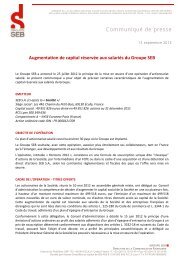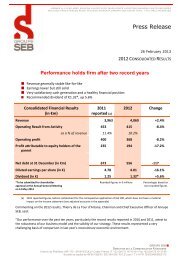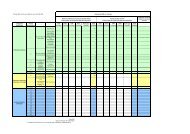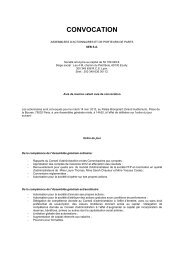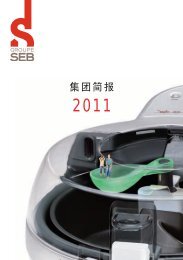Financial Report and Registration Document 2010 - Groupe Seb
Financial Report and Registration Document 2010 - Groupe Seb
Financial Report and Registration Document 2010 - Groupe Seb
Create successful ePaper yourself
Turn your PDF publications into a flip-book with our unique Google optimized e-Paper software.
1<br />
GROUPE SEB IN <strong>2010</strong><br />
BUSINESS SECTORS<br />
SEPARATE AND COMPLEMENTARY BUSINESS MODELS<br />
To respond to broad dem<strong>and</strong> ranging from first utility products to<br />
sophisticated solutions, a combination of three complementary approaches<br />
is used:<br />
an offering of basic, plain, low-priced products comprised almost entirely<br />
of finished articles procured in countries with low-cost production factors<br />
<strong>and</strong> which are used for rapid renewal of product ranges or promotional<br />
offers. The research process is then non-existent, development is short <strong>and</strong><br />
simplified, marketing <strong>and</strong> sales budgets are cut to a minimum (promotions<br />
for example). These entry-level products are mostly sold without being<br />
br<strong>and</strong>ed or under a retailer br<strong>and</strong>. In moderate growth, they represent a<br />
still modest portion of the small electrical appliance market because they<br />
concern a limited portion of the existing product offer;<br />
the development of good-quality mid-range products. The idea is<br />
to propose a full range for consumers to differentiate <strong>and</strong> renew their<br />
equipment: breakthrough products, innovative functions <strong>and</strong> unique<br />
benefits, resulting from a robust innovation approach, advanced high-tech<br />
performance, easy to use <strong>and</strong> clean, user friendly, time saving, design,<br />
h<strong>and</strong>y storage, <strong>and</strong> many more tangible features for consumers. For retail<br />
distribution, the approach translates into point-of-sale promotions <strong>and</strong><br />
store shelf layouts with the support of a steady marketing <strong>and</strong> advertising<br />
policy <strong>and</strong> an established customer service. This segment still represents<br />
the strongest part of the market, <strong>and</strong> the shrinkage factor in favour of<br />
higher-end <strong>and</strong> entry level products (hour-glass effect) has now stabilised;<br />
focus on the high-end market segment with carefully designed products<br />
which meet strict criteria of quality, results or appearance. These articles,<br />
leveraged by premium br<strong>and</strong>s, are aimed at dem<strong>and</strong>ing consumers<br />
<strong>and</strong>/or experts, looking for status symbols or high-value service. Thanks<br />
to a recent boom, these ranges are now marketed by dedicated sales<br />
teams who build genuine partnerships with selective distributors in order<br />
to exploit <strong>and</strong> optimise the huge development potential of these products<br />
in the long term. The segment is still sensitive to the economic situation,<br />
as demonstrated by the 2008-2009 crisis.<br />
These three market approach models are used together in nearly all mature<br />
markets <strong>and</strong> are beginning to appear in certain emerging markets.<br />
1<br />
MULTIPLE FORMS OF COMPETITION<br />
The Small Household Equipment market is very fragmented globally, both<br />
in small electrical appliances <strong>and</strong> in cookware. In practice, changes in the<br />
sector over the last ten years – with in particular, the increased relocation of<br />
production to countries with low production costs – have greatly changed<br />
the deal in the approach to markets, more local today than really global.<br />
For small electrical appliances, the industry’s ten biggest operators account<br />
for between €1 to €3.6 billion in sales <strong>and</strong> represent over 40% of the global<br />
market. Therefore, the Group has numerous <strong>and</strong> various competitors<br />
worldwide, but few of them have a global spectrum:<br />
Philips is certainly the fi rst rival through its small electrical appliances<br />
<strong>and</strong> its worldwide presence; other industry giants with extensive<br />
offering <strong>and</strong> global coverage include DeLonghi (DeLonghi, Kenwood…),<br />
Procter & Gamble (Braun, Oral-B), Bosch-Siemens, <strong>and</strong> Conair (Babyliss,<br />
Cuisinart…);<br />
other players are primarily present in their domestic market or a few<br />
reference markets: Magimix, Taurus, Imetec or Severin, specifi cally in<br />
various European countries; Spectrum Br<strong>and</strong>s (Black & Decker, George<br />
Foreman, Russell Hobbs, Remington…) <strong>and</strong> Jarden (Sunbeam, Mr Coffee,<br />
Oster…) in North America for example; Mallory, Mondial or again<br />
Britania, amongst others in South America; Zelmer in central Europe;<br />
Panasonic (also including the National br<strong>and</strong>) or Tiger in Japan; Midea,<br />
Joyoung or Airmate in China…;<br />
numerous high-end specialists concentrating on one or two product<br />
segments: Dyson, Vorwerk, Jura, Laurastar, etc.<br />
At the same time, another form of competition with “non-br<strong>and</strong>ed”<br />
products <strong>and</strong> retailer br<strong>and</strong>s proposes a predominantly entry-level range,<br />
which is aggressively priced as a result of one-off contracts with Chinese<br />
subcontractors.<br />
The market dynamism remains basically driven by large European groups<br />
such as <strong>Groupe</strong> SEB: Philips, Bosch Siemens or DeLonghi who develop new<br />
products <strong>and</strong> concepts, open new categories <strong>and</strong> set up in new territories.<br />
By doing this, they are winning market share, enjoying economies of scale<br />
<strong>and</strong> improving their competitiveness in terms of production, R&D <strong>and</strong><br />
retail distribution. Meanwhile, national players have grown stronger in the<br />
last years, boosting specifi c targeted offerings tailored to the markets.<br />
Furthermore, we observe the development of local competitors in booming<br />
Asian emerging markets.<br />
For certain cookware articles, the situation is even more fragmented since<br />
<strong>Groupe</strong> SEB is the only really global player. Some competitors deploy<br />
an international strategy but which is more limited geographically, or<br />
more restricted in terms of product offer. Significant international players<br />
include the US group Meyer (Silverstone, Farberware, Prestige, Anolon,<br />
Circulon br<strong>and</strong>s, etc.), the German br<strong>and</strong>s WMF (WMF, Silit, Kaiser…)<br />
<strong>and</strong> Fissler <strong>and</strong> the French Le Creuset. In addition to this structured<br />
competition, there is still a host of local players such as Staub/Zwilling in<br />
Europe, Tramontina in Brazil, ASD in China, Maspion in Indonesia, etc. plus<br />
retailer br<strong>and</strong>s which in many countries represent the Group’s only direct<br />
competition.<br />
GROUPE SEB<br />
FINANCIAL REPORT AND REGISTRATION DOCUMENT <strong>2010</strong><br />
7









